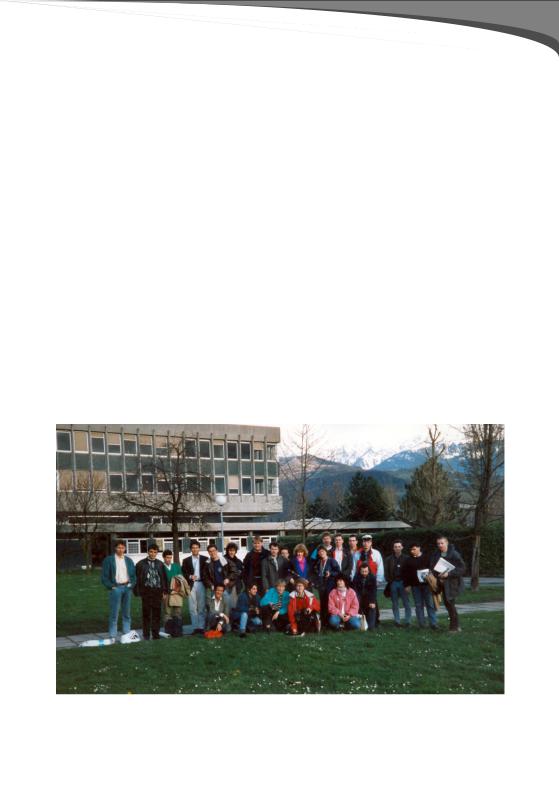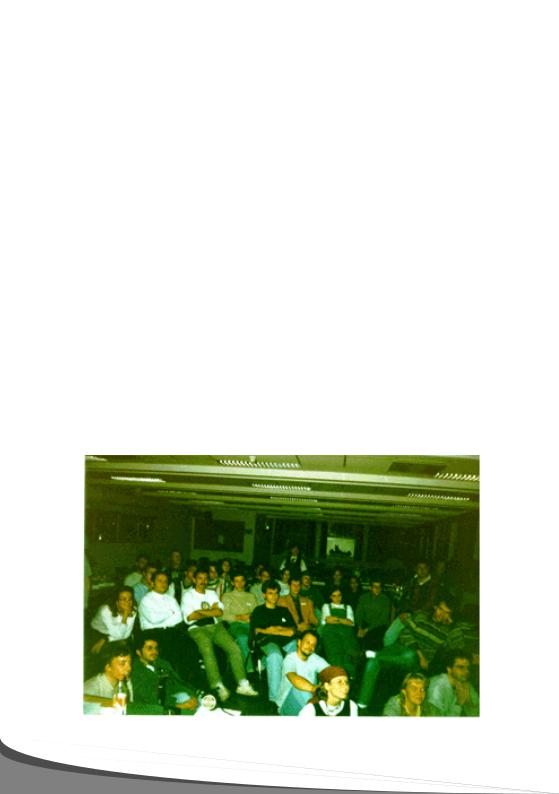
History Book of BEST
.pdf
11
BEST: Beginnings, Struggles, Milestones,
Development
Stockholm, Grenoble, Berlin
For everything that we create there is always the questions: when, why, how? When it comes to BEST there are even more questions looking for an answer. This is the story of the creation of BEST.
In Stockholm, May 1987 an event called International Week took place. Only students in physics and mathematics were invited. The universities that went to Sweden were Berlin and Aachen (West Germany), Helsinki (Finland),Imperial college of London (United Kingdom), Delft (Netherlands), Warsaw (Poland), Stockholm (Sweden), Zurich (Switzerland), Copenhagen (Denmark), EC Paris and INP Grenoble (France), Louvain-la-Neuve (Belgium).
This meeting had the main goal to set up a link between the European universities and to support the exchange of the students between these universities. As the meeting had no clear conclusion, it was decided to organise an International Week (IW) each year in a different country where problems of exchange in Europe would be discussed. Another important decision was to enlarge the board of the meeting to all Europe.
Grenoble was chosen to organise the second International Week. The aim of this second meeting was to strengthen the link between European students and to establish a new
European organization, to set up its status and to define its principal actions. It was decided that the third International Week would be held in Eindhoven in November 1988.
In October ’87 other universities were invited to participate at the event, this enabled the meeting to go up from 12 to 24 universities. In December 1987, it was considered that a yearly international week was not enough to strengthen the relationship between the European Universities; therefore, the creation of a European Association was hoped for. Prior to March ’88, students from INPG Grenoble worked hard in organizing the second International Week.
At the meeting in Grenoble, from 20th to 27th of March, universities from 13 European countries were present. The main topics of discussion were:
•European Exchanges
•Creation of the European association
•Research for new and easier ways of practical training
•Lowering the cultural barriers
First topic discussed was the functions and creation of an association (known for the present as the EAU-European Association of Universities).

Chapter 1:
BEST: Beginning, Struggles, Milestones, Development
It was considered important that the association would support students in finding employment, either vacation or longer term, abroad. There were many discussions regarding the limit of this support and exactly how this support must be given.
It was noted that the first International Week (Stockholm 1987) had provided no conclusion about the week and had produced no declaration of intent about what the week should have achieved.
The structure of the EAU was decided upon. There would be two meetings per year. The first, in November, would take the format of the current week and the second, a working reunion of 4 days (maximum) would be held in April at different location.
For the future, it was decided that prospective holders of the IW would prepare a presentation about why they should be the next organizers of the IW. At the IW the holders of the working reunion were to be chosen.
Problems about archives were raised. As no clear conclusion was reached the presidents would hold onto the relevant files - passing them on as necessary. It was decided that the committee (now known as LBG) members of the EAU would be representative in each country - one of the participants in the IW.
This association had many aims and one philosophy: “Promote Europe amongst Europeans.”
The main aims and function of this association were settled:
•Make available clear information about every university in the EAU to all interested parties.
•Mediate between universities in the EAU and between universities and firms.
•To support student initiatives concerning European-orientated affairs when possible.
Short term aims were discussed:
•Encourage the universities to accept foreign students.
•Collect information about the different universities.
•Stimulate international study-excursions.
•Get companies interested in the EAU.
And long term aims:
•Create international job-shops.
•Get propositions of jobs from foreign companies.
•Advertise the EAU in the newspapers.
•Convince universities to recognise one year of studies in another country made by their students.
•Work for more lectures in English on higher courses. Students should be allowed to answer exams in English.
•Work for exchange of three months in other university laboratories.
It was decided to give a new name for this association in the last day of the event.
12

13
“The EAU (European Association of Universities) was recognized by the French government as a non profit organisation. It was felt that the term EAU was misleading so it was decided to choose a new one on Saturday at 2.30.”-Grenoble Report, 1988
There were many proposals, some of them funny, other not. One idea was to call it NBS (No Business School) or EST (European Students of Technology), but in French EST means east. Finally, Giuseppe Margriote from Turin invented the name: BEST-Board of European Students of Technology.
At Grenoble, was also decided that a booklet would be produced by the INPG giving information about school systems in each participating country. The booklet should also provide information about companies in each country. Exactly what information could not be decided upon but it was agreed that as a start INPG should include something to this effect in the brochure they will produce.
After IW Grenoble, BEST was the name embraced by all members, and all of the documents after the event stated BEST as the European Organisation of Students of Technology, EAU being an acronym no longer used.
The next meeting was the IW in Eindhoven that started on 6th November 1988. The main aims of the discussions were to define what needed to be done until the next IW in order to keep BEST together as an association and to set up the main topics of discussion for the next WR.
Paticipants at First BEST meeting in Grenoble in 1988

Chapter 1:
BEST: Beginning, Struggles, Milestones, Development
This was one of the most productive meetings they had as the agenda was to define BEST.
In Eindhoven, they were discussing about the statutes of the organization, how will this association help students all over Europe, the communication between the groups and the financing of such an organization. . They also discussed the future steps and what needed to be done until the next meeting.
Even if BEST had no financial means, the members succeeded in publishing and sending newsletters with news from all countries members of BEST, words from the international management of BEST and future organizers of the IW from Vienna , 1989.
The next meeting and probably most important meeting for BEST took place in Berlin, in
April from 10th to 14th. This meeting was the first one exclusively for BEST members.
Students from all over Europe participated at this event: Barcelona, Berlin, Bologna, Budapest, Eindhoven, Grenoble, Helsinki, Lisbon, Ljubljana, London, Louvain-La-Neuve, Paris, Stockholm, Trondheim, Turin, Vienna, Warsaw and Zurich.
The aims of this working reunion were well known: to define the statutes by which BEST will abide in the future and to define plans on which the organization will concentrate future actions. For all of these topics to be reached and to have clear conclusions, the participants were split into 2 groups: the first group took care about the statutes of the organization and the second one had to define a strategy, a plan that would ensure the development of
BEST.
BEST had been registered as a non-governmental organization in France, so it is subject to French law even if the members are not French citizens. At the statutes topic, many aspects were discussed: structure of the organization, admission of new members, purpose of BEST, resources and expenses, exclusion from BEST, membership of the organization and internal regulations.
The first discussions were about the content of the statutes. The definition of the association, its goals and the seat of the different bodies of administration as well as their personal information were included in the statutes.
Regarding the structure, the delegates decided that BEST would conclude of the Board, a General Assembly and members. Any decision that was not included in the statutes, according to the French laws, must have been voted unanimously by the General Assembly. A secretariat was to be chosen by the president to distribute the reports of the meetings and to take care of the documents of BEST.
After much discussion, the first group presented to the plenary a preliminary version of the statutes consisting of 15 articles that reached the topics mentioned above and many more.
14

15
The second group discussed future plans. The delegates of the second group split into more groups and reached themes like information –inside and outside the organization, exchange of students in Europe and cooperation between BEST and international companies.
Regarding inside information, a questionnaire was given to the member universities of BEST, and each university would send the filled questionnaire to all other universities. This way, the member universities would know more about one another. Another important point was the logo of BEST. Even if there were 3 proposals for a new logo (sinus wave, “atomic model” and “circle”), the plenary decided to keep the old one but to redesign it including the sinus wave in it. The final design was made by BEST members from Switzerland.
The exchange topic produced three conclusions regarding the involvement of BEST in exchange issues: on long term, BEST should convince more professors to support students that go on exchange programs, for short term exchanges, BEST was to involve informally and inform the universities through newsletters about this opportunities and for the EEC Engineering Degree, Lisbon and London should get informed and this topic was to be discussed in the next meeting.
The idea of job fairs, then called jobshops was raised. The difference between international jobshops and national job shops was settled and they all realised that at national level the members were organizing this kind of events, and an international jobshop would be a big challenge for all BEST members.
In the last days of the event in Berlin, the new board of BEST was decided. Even if in the board should have been members from Vienna, as this group was the organizer of the next meeting, Ida Law from Trondheim was the first president. Vienna wasn’t a full member of
BEST. The members of the group that were organizing the BEST meeting after Vienna took the challenge.
After these steps were made, in the mind of every BEST member were the words as found in the first report of BEST in 1988, IW Grenoble: “Good luck to BEST!”
Article written by Mirela Andriescu
Defining BEST, Identity of BEST
Creating a new organisation was a great task for students of technology. Even if there was a long way until the finish line, their will was enough to determine a series of events that concluded in the definition of BEST.

Chapter 1:
BEST: Beginning, Struggles, Milestones, Development
After International Week (IW) Stockholm in 1987, the participant universities wanted to continue their cooperation and decided that a new body must be created: European Association of Universities (EAU). Even from the beginning they tried to create a set of rules that would ensure the efficiency of their work and a long existence.
A huge step was made in the next year at Grenoble IW, where the basis of BEST was set. After choosing the name of the organisation, the delegates discussed about communication inside the organisation and concluded that every 2 months a newsletter must be sent to all of the participant universities.
At the same meeting the aim of the organisation was defined: “To facilitate the exchange of students and information” among the different universities under the philosophy “To promote Europe among Europeans”.
Other aspects like the status of the organisation, the funding, internal structure and logo issues were poorly discussed, so the delegates decided that at the next meeting, the working reunion in Eindhoven 1988, all of these details were to be cleared.
The purpose of the meeting in Eindhoven was to define BEST and its activities.
The agenda discussed even from Grenoble meeting had some points as: meaning of BEST, statutes of BEST, structure and identity of the organisation.
First topic on the agenda was “Why BEST?”. “This point was really encouraging because after a while’s discussion, everybody present seemed eager to join up with the association and work with it. Let’s hope that enthusiasm continues!” (Eindhoven report, 1988)
For the topic “How BEST” the delegates identified 4 different subtopics: communication with the other European universities, financing of the organisation, creating new groups to promote BEST in the European universities, the aims and constitutions of the local groups.
The delegates were split into 4 different groups and each group needed to find solutions for one specific topic mentioned above. At the end of the meeting, the conclusion was discussed in the plenary.
Communication inside the organisation
After debating this topic, the group identified two ways to exchange information: through meetings or an information network.
Even if direct contact is the most efficient way of communicating, only few days per year are not sufficient to sustain a European association. So the idea of an information network popped up in the delegates’ minds. Its main institution should be the Central Secretariat that would fulfil the following functions:
•collecting information about the work of BEST
•receiving request for information about BEST
•selecting the universities to pass this information out to
The means of communication was the snail mail, telex, telefax and telephone. There were
16

17
discussions about the idea of a computer network between universities. The structure and constitution of the central secretariat couldn’t be set as the delegates didn’t know what the best solution was: to have the office of this secretariat in a university, or to move it from time to time between universities.
Regarding funding, the main question was who should be responsible for raising the money and who should distribute it. The organisers of the IW or Working Reunion (WR) should be able to provide lodging and food for the delegates and the participants should take care of their transport to the location. Another aspect was the funding of the central secretariat and it was decided that the secretariat should take care of the expenses on its own. A daring and new idea was the cooperation with companies: to receive financial support from them and provide them the chance to present their opportunities to the BEST members.
The next big subject was the creation of local groups in the European universities and getting them acknowledged. As the universities were so different, there was no common approach or formula to create a BEST group. However, the participants had the responsibility of creating such a group in their university.
For the creation of each local committee a set of guidelines was created by the Strategy Group. The most important thing was to establish a relationship with the university, with the professors and administration alike for their academic and logistic support.
Every founder should then send a report to all other universities, members of the organisation, to detail on the creation of their group.
In long term, the participants decided upon the structure and next steps of BEST. The Administrative Council was considered to be the members of the group who were organising an International Week and all of the members should research on the steps of juridical creation of a student organisation in their university.
The meeting in 1989, in Berlin was the biggest step BEST made as a European organisation. One thing was clear: BEST was registered in France, in Grenoble and was subject to French laws. However, the big task was to make clear to all participants what was BEST and the rules all of the local committees had to follow.
A big part was the statutes and internal regulations topic. Many aspects were discussed: structure of the organization, admission of new members, purpose of BEST, resources and expenses, exclusion from BEST, membership of the organization and internal regulations. For these and other many topics articles were stipulating the general rules that BEST had to abide by.
In 1990 after the GA in Budapest, the statutes and internal regulations were revised and consisted of 15 articles about the statutes and 11 articles with the internal regulations of BEST.
After 2 years of struggles, Europe had a new students’ organisation. In those days, the

Chapter 1:
BEST: Beginning, Struggles, Milestones, Development
biggest challenge was to maintain BEST alive and secure its continuity and growth.
In 1991 at the GA in Paris, BEST made a step forward: did BEST need a board? That was the question on every delegate’s lips after a little misunderstanding about who should represent BEST in the meeting with P&G.
While studying the board issue, 5 subgroups decided to propose a new structure of BEST consisting of the General Assembly as the legislative body who elects the president, the board and the organising group of the next GA. The delegates were afraid that with this structure some groups would become too powerful, so instead they agreed that the president of BEST should have an advisory committee with a formal role to assist the president, maintain communication and create proposals for the agenda of GAs.
The homework
To keep BEST alive, communication between the local groups was mandatory. The only way this was done was through telephone and newsletters. Another way to preserve BEST and to evolve was to actually get some work done. Therefore, tasks were given at each GA to LBGs and were very diverse: from the summer program and ways to improve it to structure of BEST, newsletters and nursing baby LBGs.
At the same GA, the delegates were split into several subgroups and discussed future policies and projects, future of BEST, structure of BEST. Thinking of the future of BEST, the delegates suggested different ideas:
•an International Contest that was approved by the GA,
•a BEST week similar to a conference (which was not approved)
Other topics discussed were the common image, English courses of 2 weeks for BEST members and a BEST all around Europe trip.
One important topic was the acceptance procedure of new groups inside BEST as it was not clear and understandable to new comers what are the needed steps to become baby LBGs.
In 1993 a Continuity group was created that evaluated the process of continuity inside BEST. The main tool that assured the continuity was the homework for LBGs system. This group had to read and evaluate all of the reports of the homework made by LBGs and even propose new ones. “The homework ensures our continuity; they link one GA to the next one and also the LBGs together. Therefore it appears necessary to keep them even if we have to select the important ones and stop the unproductive ones.” (Report of Continuity Group at GA Warsaw, 1993).
They encouraged the continuation of projects with potential like
•BEST magazine,
•BEST Internal Publication List,
•Vacation list,
•Best Computer Network (BCN) and
•promotion of BEST
18

19
They proposed the BCN and the contact with the European Commission as permanent homework. In their report they gave guidelines for creating homework so that the LBGs understand better what needs to be done and the importance of permanent homework.
At the GA in Warsaw a big topic was the life and progress of BEST. The delegates divided this into 5 subtopics:
•Vision/Mission/Goals
•Environment
•Outputs of BEST
•Decision making
•Communication
The most important outcome after the discussion was what we know as Statement of Purpose. Paolo Bianco from Torino proposed that the statement to be included in the statutes of BEST. Although no decision was taken regarding this issue, the delegates approved considerable changes to the statutes and Internal Regulations and made clearer the admission and exclusion of LBGs and the structure of the management of BEST and its role.
The idea of an Action Plan for a specified period of time was well received by the delegates.
For the communication inside the organisation they emphasized the usage of email as the main communication tool.
The concept of strategy was better explained by a document named “Strategy” at GA Turin
1994. It presented the benefits of having a strategy how you can build up a strategy and why BEST needed one to ensure its growth and prosperity.
After this moment, an international committee was created to work on the strategy of
BEST. It was approved along with the Technical Committee, Structure Committee, PR and
Industry Committee.
Other important aspects were the changes to the Statement of purpose and Paolo Bianco’s speech about how can we use it. The Statement of Purpose consisted of:
“We will strive to develop activities in order to help our fellow European students of technology to become more internationally-minded, by reaching a better understanding of European cultures and developing capacities to work on an international basis.
We will achieve this purpose through the active involvement of our members, in challenging and innovative projects, providing the conditions for their personal development and putting their abilities to full use. We will value integrity and seek wide range contributions to the advancement of the Association.
We thus expect to provide European engineering students with complementary education, while broadening their knowledge of other cultures. As result, we hope to bring a significant added value to the training provided by the Universities, therefore increasing the potential contribution of students to their communities.”

Chapter 1:
BEST: Beginning, Struggles, Milestones, Development
At the same event, they had the first discussions about a one year mandate for the
International Board instead of half a year. The main reason was the lack of time for the Board to implement their decisions and plans.
By GA 1994 in fall, the Strategy Committee had started to work. Some steps were designed: to study what was done prior, to identify the projects of BEST, to sustain and to improve them. For its growth and stability, BEST had to identify the needs of its stakeholders: students, members of the organisation, universities and companies alike. These needs were the starting points from which a solid strategy would be created and followed.
The 3 Year Plan
In 1995, BEST members discovered some problems with BEST’s continuity. Many of the reports of the previous events that offered solutions for some of BEST’s problems were forgotten. This way a knowledge transfer was faulty. For this, a possible solution was the 3 Year Plan (3YP).
“The 3 Year Plan is a possibility for BEST to have long time planning. It allows us to write down what BEST wants to achieve in three years. There should be goals that are easy to measure. These are goals you can measure as time is passing and gives BEST the opportunity to evaluate the plan after some time. The idea has popped up many times in BEST and now we hope that the 3YP will be just as integrated into not only the Board but also the whole of BEST.” (GA Patras report, 1995)
The First PM Plenary : PM Trondheim, 1995
20
